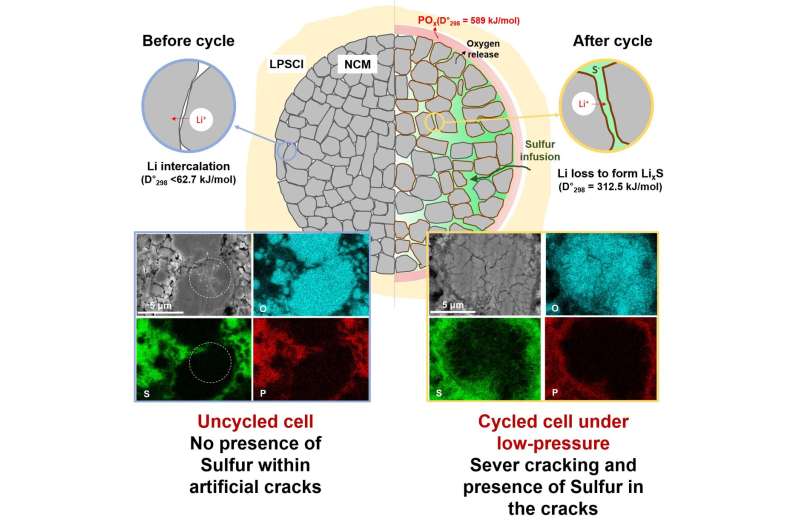This article has been reviewed according to Science X's editorial process and policies. Editors have highlighted the following attributes while ensuring the content's credibility:
fact-checked
peer-reviewed publication
trusted source
proofread
Investigation of degradation mechanism for all-solid-state batteries takes another step toward commercialization

Often referred to as the "dream batteries," all-solid-state batteries are the next generation of batteries that many battery manufacturers are competing to bring to market. Unlike lithium-ion batteries, which use a liquid electrolyte, all components, including the electrolyte, anode, and cathode are solid, reducing the risk of explosion, and are in high demand in markets ranging from automobiles to energy storage systems (ESS).
However, devices that maintain the high pressure (10s of MPa) required for stable operation of all-solid-state batteries have problems that reduce the battery performance, such as energy density and capacity, and must be solved for commercialization.
Dr. Hun-Gi Jung and his team at the Energy Storage Research Center at the Korea Institute of Science and Technology (KIST) have identified degradation factors that cause rapid capacity degradation and shortened lifespan, when operating all-solid-state batteries at pressures similar to those of lithium-ion batteries. The research is published in the journal Advanced Energy Materials.
Unlike previous studies, the researchers confirmed for the first time that degradation can occur inside the cathode as well as outside, showing that all-solid-state batteries can be operated reliably even in low-pressure environments.
In all-solid-state batteries, the cathode and anode have a volume change during repeated charging and discharging, resulting in interfacial degradation such as side reaction and contact loss between active materials and solid electrolytes, which increase the interfacial resistance and worsening cell performance.
To solve this problem, external devices are used to maintain high pressure, but this has the disadvantage of reducing energy density as the weight and volume of the battery increase. Research is being conducted on the inside of the all-solid-state cell to maintain the performance of the cell, even in low-pressure environments.

The research team analyzed the cause of performance degradation by repeatedly operating a coin-type all-solid-state battery with a sulfide-based solid electrolyte in a low-pressure environment of 0.3 MPa, similar to that of a coin-type Li-ion battery.
After 50 charge-discharge cycles, the NCM cathode layer had expanded in volume by about two times, and cross-sectional image analysis confirmed that severe cracks had developed between the cathode active material and the solid electrolyte. This revealed that in addition to the interfacial contact loss, cracking of the cathode material and irreversible cathode phase transformation are the causes of degradation in low-pressure operation.
After replacing the lithium in the cathode with an isotope (6Li) to distinguish it from the lithium present in the solid electrolyte, the team used time-of-flight secondary ion mass spectrometry (TOF-SIMS) to identify, for the first time, the mechanism by which lithium consumption in the cathode contributes to the overall cell capacity reduction.
During repeated charge-discharge cycles, sulfur, a decomposed product of the solid electrolyte, infused the cracks in the cathode material to form lithium sulfide, a byproduct that is non-conductive. This depleted the active lithium ions and promoted cathode phase transformation, reducing the capacity of the all-solid-state batteries.
By clearly identifying the cause of the degradation of all-solid-state batteries in low-pressure operating environments, these analytical methods provide a clue to solving the problem of poor cycling characteristics compared to conventional lithium-ion batteries. If this problem is solved, it is expected that the economics of all-solid-state batteries can be secured by eliminating external auxiliary devices, which have been a major cause of rising production costs.
"For the commercialization of all-solid-state batteries, it is essential to develop new cathode and anode materials that can be operated in a pressure-free or low-pressure environment rather than the current pressurized environment," said Dr. Hun-Gi Jung of KIST.
"When applying low-pressure-working all-solid-state batteries to medium and large-scale applications such as electric vehicles, it will be expected to make full use of established lithium-ion battery manufacturing facilities."
More information: Hyeon‐Ji Shin et al, New Consideration of Degradation Accelerating of All‐Solid‐State Batteries under a Low‐Pressure Condition, Advanced Energy Materials (2023). DOI: 10.1002/aenm.202301220















